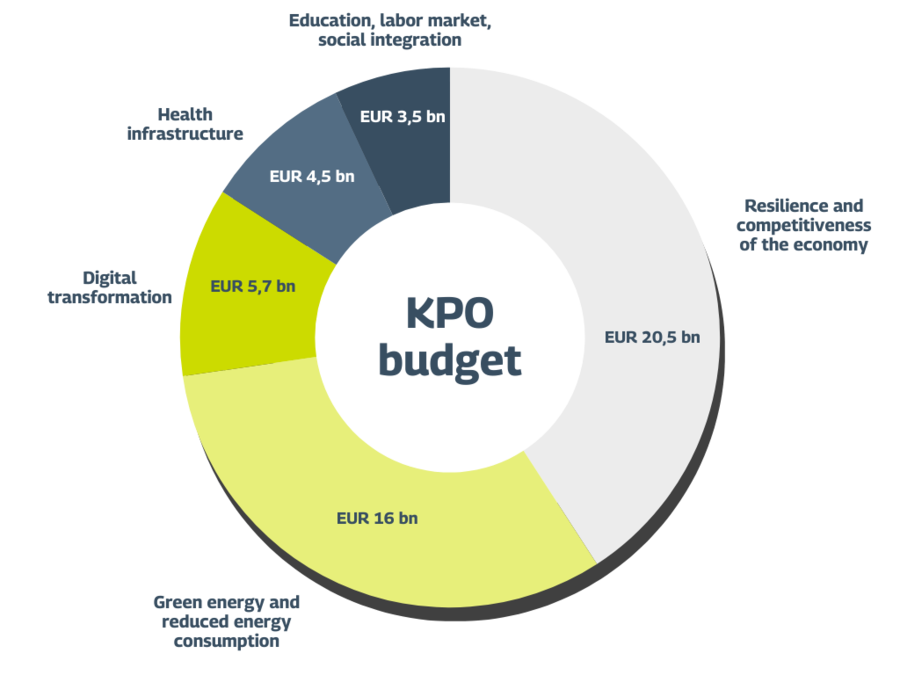How to obtain funds from the Polish National Recovery Plan (KPO)?
The National Recovery Plan (KPO) is a strategic document that plays a key role in rebuilding the Polish economy after the COVID-19 pandemic, focusing on modernization towards green transformation, digitalization, and innovation. The program, financed mainly from EU funds, offers a significant opportunity for Polish entrepreneurs, especially those operating in the industrial sector, to invest in energy efficiency, renewable energy sources, digitalization, and innovative technologies. Find out how to obtain funds from the KPO, what its budget and application assessment criteria are, and who has the best chance of receiving support.

What is the National Recovery Plan?
The National Recovery Plan is the Polish component of the EU Recovery and Resilience Facility (RRF), part of the Next Generation EU package. The aim of the KPO is to rebuild the economy after the crisis caused by the COVID-19 pandemic, while accelerating energy transformation, digitalization, and strengthening economic innovation.
You can find more about what KPO is and what it offers here: National Recovery Plan
The National Recovery Plan focuses on three main areas:
- Green transformation – reducing CO2 emissions, investing in renewable energy sources, energy efficiency, and decarbonizing industry.
- Digitalization – supporting the implementation of modern digital technologies in companies and developing IT infrastructure.
- Innovation – promoting new technologies and processes that will increase the competitiveness of Polish enterprises on the international market.
The KPO budget: how much is it, and how is it distributed?
The total budget of the National Recovery Plan for Poland is approximately EUR 58 billion, of which about EUR 23.9 billion are grants, and EUR 34.2 billion are preferential loans.
The KPO funds are distributed across five main pillars:
- Resilience and competitiveness of the economy – EUR 20.5 billion.
- Green energy and reduction of energy intensity – EUR 16 billion.
- Digital transformation – EUR 5.7 billion.
- Health infrastructure – EUR 4.5 billion.
- Education, labor market, social integration – EUR 3.5 billion.

These funds support a broad range of activities that promote innovation, energy efficiency, and the digitalization of companies and institutions in Poland.
Who can obtain funds from the KPO?
Funds from the KPO are available to a wide range of recipients, including:
- Industrial companies that can implement investments related to energy efficiency, digitization, infrastructure modernization, and decarbonization of production.
- SMEs (Small and Medium-sized Enterprises) with plans related to innovation, automation of production processes, and implementation of Industry 4.0 technologies.
- Public sector entities, such as local governments and public institutions, which can obtain support for infrastructure modernization and digitization of public services.
- Entrepreneurs from the RES industry (Renewable Energy Sources) who want to invest in renewable energy technologies like photovoltaics, wind energy, biogas, or energy storage.
Companies with the highest likelihood of receiving support are those aligned with the program’s goals, such as plans to increase energy efficiency, reduce CO2 emissions, implement technological innovations, and improve economic competitiveness. Companies with strategic plans for energy transformation and digitalization will receive priority consideration during the application assessment process.
How to obtain funds from the KPO?
The application process for KPO funds involves several steps. Companies interested in obtaining support should follow these guidelines:
- Identify the investment project – Companies should clearly define the project they want to implement and how it aligns with the KPO objectives. The project should contribute to goals like energy transformation, digitalization, or innovation.
- Prepare the application – The application must include a detailed project description, an implementation schedule, cost analysis, and expected results (e.g., reduction of CO2 emissions, increased energy efficiency). In some cases, an Energy Efficiency Audit may be required as part of the application process.
- Submit the application to the relevant institutions – Applications are submitted to designated institutions, such as the National Economy Bank (BGK) or the National Fund for Environmental Protection and Water Management (NFOŚiGW). Each institution responsible for distributing KPO funds has its own submission schedule.
- Application assessment – The institutions responsible for application assessments will check the project’s compliance with KPO objectives and its financial viability. Companies that prepare thorough applications can expect quicker decisions.
- Project implementation – After receiving funding, companies can begin implementing their project. It is crucial to follow the project’s assumptions and provide regular progress reports.
"The ideal tool for identifying and verifying potential savings from a given project is the Walk-Through Audit. At DB Energy, we often recommend this step because it is low-cost or free and allows for an easy and accurate assessment of the effectiveness of various investments. Walk Through involves analyzing documentation and visiting the plant. This helps identify the most promising projects that best meet the company’s needs while maximizing the benefits of the investment." says Przemysław Kurylas, Operations Director at DB Energy.
What projects have the greatest chance of receiving funding from the KPO?
Projects most likely to receive KPO support are those that contribute significantly to the green transformation, digitalization, and increased competitiveness of the economy. Examples of such projects include:
- Investments in renewable energy sources – Projects like photovoltaics, wind farms, energy storage technologies, or biogas plants that aim to increase the share of renewable energy and reduce CO2 emissions.
- Energy modernization – Thermal modernization of industrial buildings, improvements in energy efficiency at production facilities, including heat recovery, optimization of energy generation, and modernization of technological installations, heat pump installation, or energy management systems (EMS).
- Digitization of industry – Automation and robotization of production processes, implementation of Industry 4.0 technologies, IT infrastructure expansion, and the adoption of artificial intelligence and big data systems.
- Technological innovations – Developing new technologies, products, and services that enhance the company’s competitiveness on the global market.
The National Recovery Plan offers Polish companies immense opportunities to finance investments that are critical to the future of the economy. The KPO budget, amounting to EUR 58 billion, supports energy transformation, digitalization, and innovation in Polish industry. Companies seeking KPO funding must prepare applications that align with the program's objectives. Those focused on green energy, energy efficiency, and digitalization have the greatest chance of securing support.